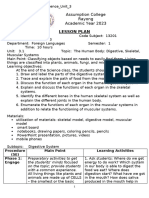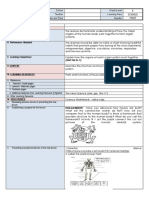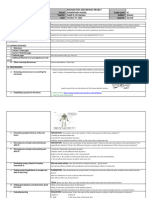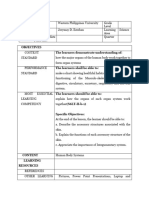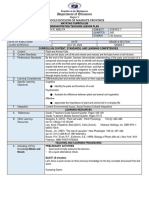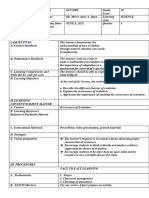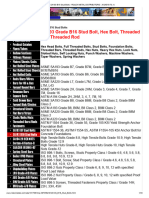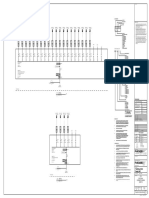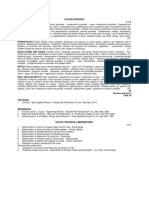Lesson Plan Anatomy
Lesson Plan Anatomy
Uploaded by
Sultan Rito AnthonyCopyright:
Available Formats
Lesson Plan Anatomy
Lesson Plan Anatomy
Uploaded by
Sultan Rito AnthonyCopyright
Available Formats
Share this document
Did you find this document useful?
Is this content inappropriate?
Copyright:
Available Formats
Lesson Plan Anatomy
Lesson Plan Anatomy
Uploaded by
Sultan Rito AnthonyCopyright:
Available Formats
School Gingoog Christian Grade Level College 3rd year
College
Teacher Rito Anthony O. Sultan Learning Function of the
Area integumentary system
COLLEGE 3RD YEAR Teaching Dates May 4, 2024 Quarter
DAILY and Time 8:00 AM- 11:00 AM 2ND SEMESTER
LESSON LOG
I. OBJECTIVES
A. Content Standards
B. Performance Standards The learners shall be able to understand the Function of the
Integumentary System
C. Learning Competencies and
Write the LC code for each
D. Learning Objectives
At the end of the session, the students should be able to:
Describe the function of the integumentary system
identify common skin disorder and their causes
appreciate the significance of maintaining skin health through
personal care practices
II. LEARNING
CONTENT/SUBJECT MATTER
A. Topic Function of the Integumentary System
B.. References/Textbooks/Manual “Anatomy & Physiology” by Elaine N. Marieb and Katja
Hoehn 10th Edition
https://openstax.org/books/anatomy-and-physiology-2e/pages/
5-1-layers-of-the-skin
https://www.ncbi.nlm.nih.gov/books/NBK470464
C. Instructional Materials
Appropriate technology to present the power point
YouTube video sharing
Activity sheets, DIY IMs
D. Strategies Lecture, Individual Activity and Group Activity
E. Values Integration Promoting practices that support skin health and well-being and
Encouraging self-acceptance and positive body image regardless of skin
appearance or conditions.
III. PROCEDURES
Face to face learning
A. Preliminaries MANAGEMENT OF LEARNING (MOL)
a. Prayer
b. Words of Welcome
c. Reminders and Announcements
d. House rules reminders
e. Setting the mood of the class (attentiveness)
Settle the class first before starting the lesson.
B. ELICIT (Review) ORAL RECITATION
Reviewing previous lesson or
presenting the new lesson Recalling previous lesson; and
Introducing new lesson
GROUP ACTIVITY: MATCH-ME-MASTER
DIRECTIONS: The teacher will paste pictures and their corresponding
definitions on the board. Students will come to the board and match the
pictures to their correct definitions.
Skin- is the largest organ of the human body, serving as a protective
barrier against the external environment.
Nails- are the hard coverings at the tips of our fingers and toes, made of
a tough protein called keratin. They help protect the fingertips and toes.
Hair- is a protein filament that grows from follicles in the skin. It
comes in different colors, lengths, and textures.
C. ENGAGE (Motivate)
Establishing a purpose for the 1. What is the integumentary system
lesson 2. Do you know why the skin is considered the largest organ in the
human body?
3. What are the functions of our skin
3. How does the skin help in regulating body temperature?
D. EXPLORE (Activity) GROUP ACTIVITY: Skin Function Discovery Challenge
Presenting examples/instances DIRECTIONS: Direction:
for the next lesson
The teacher will divide the class into 2 teams. Each group will choose 2
representatives. The teacher instructs the representatives on what skin
function to demonstrate. Representatives act it out while their team
writes their guess on a cardboard. Each team will only have 15 seconds
to guess. When the time is up, teams will raise their answer cards. Be
reminded that representatives must refrain from giving verbal clues or
signals to their team, as doing so results in minus points. 5 points each
correct answer.
E. EXPLAIN (Discussion) LECTURE DISCUSSION
Discussing new concepts and Integumentary system consists of ?
practicing new skills How does the integumentary system contribute to
protection, sensation, regulation, and secretion?
What are the layers of the skin, and what are their
functions?
What are some common skin disorders and diseases, and
what are their causes, symptoms,
What are some factors that can affect the overall health
and condition of the integumentary system?
E. ELABORATE/APPLICATION GROUP ACTIVITY GAME: I GOT YOU
(Generalizations)
- Developing mastery Mechanics: Using a spin the wheel random picker, a student name
- Finding practical applications of will be chosen to answer the given question. If the chosen student
concepts and skills in daily living cannot answer, they will remain stand and the teacher will spin the
- Making generalizations and wheel again to select another student to save them. Student who got
abstractions about the lesson the correct answer will receive 5 points.
Questions:
1. What are the 2 main types of cellular transport mechanisms?
2. Explain how osmosis helps in the regulation of water balance
in cells?
3. Describe the role of active transport in maintaining the
concentrations of ions inside cells?
4. What would happen to a cell if it couldn’t perform
endocytosis?
5. Can you explain how exocytosis contributes to keeping the
cells internal environment stable?
F. EVALUATE MULTIPLE CHOICE QUIZ (1-5)
Evaluating learning
1. Which of the following is an example of passive transport?
a) Endocytosis
b) Active transport
c) Facilitated diffusion
d) Exocytosis
2. Which of the following processes requires a concentration gradient to
move substances across the cell membrane?
a) Diffusion
b) Osmosis
c) Active transport
d) Exocytosis
3. Which type of transport requires energy in the form of ATP?
a) Diffusion
b) Osmosis
c) Active transport
d) Facilitated diffusion
4. What is the primary function of endocytosis?
a) Excreting waste products
b) Taking in nutrients and large molecules
c) Releasing substances from the cell
d) Maintaining cell shape
5. Which process involves the fusion of vesicles with the cell membrane
to release substances outside the cell?
a) Endocytosis
b) Osmosis
c) Exocytosis
Additional d) Active transport
G. EXTEND(Assignment) ASSIGNMENT
- activities for application for
remediation INSTRUCTIONS: In a ½ sheet of paper, list 5 organelles found in
the cells, and provide a brief description of its structure and
function
Prepared by:
MERRY ANNE A. DAYA
BSED SCIENCE III STUDENT
Checked by:
DAHLIA M. MAPUTOL
SCI 316 INSTRUCTOR
You might also like
- Lesson Plan For Anaphy AnnDocument4 pagesLesson Plan For Anaphy AnnSultan Rito AnthonyNo ratings yet
- DLP SCIENCE 6 Q2 WK 1 Day 4Document8 pagesDLP SCIENCE 6 Q2 WK 1 Day 4Roselle Joy EgeraNo ratings yet
- 03 Biological OrganizationDocument2 pages03 Biological OrganizationIrish May TroyoNo ratings yet
- DLL On The Nerve Cell (Kimberly Manahan)Document3 pagesDLL On The Nerve Cell (Kimberly Manahan)Silver RitzNo ratings yet
- DLL_SCIENCE 6_Q2_W1Document4 pagesDLL_SCIENCE 6_Q2_W1Mishelle BaslagNo ratings yet
- Semi Detailed Lesson Plan in Science 6 TOVILLO JULIE D.Document2 pagesSemi Detailed Lesson Plan in Science 6 TOVILLO JULIE D.Julie De Blas Tovillo100% (4)
- 04 Pyramid Biological Organization ProjectDocument2 pages04 Pyramid Biological Organization ProjectIrish May TroyoNo ratings yet
- Lesson Plan SCIENCE 6 (WEEK 3, DAY 2)Document3 pagesLesson Plan SCIENCE 6 (WEEK 3, DAY 2)Angel rose reyes100% (1)
- 7es Nervous and Homeostasis LPDocument4 pages7es Nervous and Homeostasis LPGenessa CalibayNo ratings yet
- Cot DLP Digestive System 1Document4 pagesCot DLP Digestive System 1Jonathan Paguio Lalican Lpt100% (2)
- 20organsystemofrep.animalsDocument5 pages20organsystemofrep.animalsAngel AlibangbangNo ratings yet
- Cot DLP Digestive SystemDocument5 pagesCot DLP Digestive SystemHeidi Dalyagan Dulnagon100% (2)
- Cot DLP Digestive SystemDocument4 pagesCot DLP Digestive SystemAvrenim Magaro Decano100% (6)
- Science 8 - 8Document4 pagesScience 8 - 8Sherine Marianne IgnacioNo ratings yet
- LP 2023 Sem1 P3 Unit3 5emodelDocument12 pagesLP 2023 Sem1 P3 Unit3 5emodelRuth KayatNo ratings yet
- Lesson Plan SCIENCE 6 (WEEK 1, DAY 1)Document3 pagesLesson Plan SCIENCE 6 (WEEK 1, DAY 1)Angel rose reyes100% (1)
- DLL - Science 6 - Q2 - W7Document3 pagesDLL - Science 6 - Q2 - W7nida.baul001No ratings yet
- Cot DLL ScienceDocument3 pagesCot DLL ScienceTrisha Mae Manalo80% (5)
- LP 2023 Sem1 P3 Unit3.2 5emodelDocument9 pagesLP 2023 Sem1 P3 Unit3.2 5emodelRuth KayatNo ratings yet
- 7es Nervous and Homeostasis FINAL NATO!Document4 pages7es Nervous and Homeostasis FINAL NATO!Genessa CalibayNo ratings yet
- Lesson Plan (Skeletal)Document3 pagesLesson Plan (Skeletal)exudor rosalesNo ratings yet
- DLL - Science 6 - Q2 - W1Document10 pagesDLL - Science 6 - Q2 - W1maricel ariasNo ratings yet
- Detailed Science Lesson Plan: Grade LevelDocument3 pagesDetailed Science Lesson Plan: Grade LevelArnel Bilayong100% (1)
- LP Science Co1Document4 pagesLP Science Co1FRANCIS JAKE SENOBIONo ratings yet
- Cot Digestive System 2nd QuarterDocument8 pagesCot Digestive System 2nd QuarterestorninosabiNo ratings yet
- WEEK 1, d1Document6 pagesWEEK 1, d1Genesis MartinezNo ratings yet
- May 8-12Document4 pagesMay 8-12Irish OmpadNo ratings yet
- Science Q2 WEEK 1Document22 pagesScience Q2 WEEK 1Isaiah De GuzmanNo ratings yet
- Science Lesson Plan Grade Level: 10 Date: Wednesday, June 26, 2019Document3 pagesScience Lesson Plan Grade Level: 10 Date: Wednesday, June 26, 2019Maiza TiborNo ratings yet
- Science DLPDocument5 pagesScience DLPVismay Mona AttarNo ratings yet
- AnaPhy Lesson PlanDocument12 pagesAnaPhy Lesson PlanESCARO, JOSHUA G.No ratings yet
- DLL Endocrine System 5Document2 pagesDLL Endocrine System 5Jomalyn DaduyoNo ratings yet
- Science 9 DLP Q1W1D1RespiratoryDocument6 pagesScience 9 DLP Q1W1D1Respiratorysophia tanNo ratings yet
- DLP Homeostasis and Body SystemsDocument8 pagesDLP Homeostasis and Body SystemsJames GalvezNo ratings yet
- I. Objectives: Implementation of Policies, Guidelines, and ProceduresDocument18 pagesI. Objectives: Implementation of Policies, Guidelines, and ProceduresRose Aileen EndigadoNo ratings yet
- 1 BIO LP 3 EditedDocument5 pages1 BIO LP 3 EditedRosemarie Soldevilla LanderoNo ratings yet
- Lesson Exemplar in SCIENCE 6 Quarter 2 CALANGINDocument7 pagesLesson Exemplar in SCIENCE 6 Quarter 2 CALANGINCALANGIN, MELANIE C.No ratings yet
- Lesson Plans For DemoDocument4 pagesLesson Plans For DemoMikael UngkayNo ratings yet
- Lesson-Plan-School DemoDocument4 pagesLesson-Plan-School DemoBlezy GuiroyNo ratings yet
- Lesson Plan in Science 7Document4 pagesLesson Plan in Science 7Nelly Ballejos100% (1)
- Lesson Plan 2022Document6 pagesLesson Plan 2022Jeramie Mabaet JabagatNo ratings yet
- Cse LPDocument10 pagesCse LPeden100% (1)
- DLP - How The Different Body Organs Work TogetherDocument9 pagesDLP - How The Different Body Organs Work TogetherMarilou Utrera- Paclob100% (1)
- DLL Science-6 Q2 W1Document8 pagesDLL Science-6 Q2 W1MELISSA PANAGANo ratings yet
- Matatag DemoDocument8 pagesMatatag Demomaria roseNo ratings yet
- UntitledDocument4 pagesUntitledJohn Loreto MentesNo ratings yet
- ELS - DLL - Module 6 - ENDOCRINE SYSTEMDocument4 pagesELS - DLL - Module 6 - ENDOCRINE SYSTEMMitze QuinonesNo ratings yet
- 7es Nervous and HomeostasisDocument4 pages7es Nervous and HomeostasisGenessa CalibayNo ratings yet
- Cot LP 2019-2020Document9 pagesCot LP 2019-2020JESSICA ARNADONo ratings yet
- Pagdato Cot Digestive-SystemDocument9 pagesPagdato Cot Digestive-SystemDave Joshua BrownNo ratings yet
- CellDocument4 pagesCellMarenella RabanzoNo ratings yet
- Le - Digestive SystemalmostdoneDocument4 pagesLe - Digestive Systemalmostdonesingleshot2024No ratings yet
- Lesson 2Document4 pagesLesson 2Raymond BugagaoNo ratings yet
- Lesson PlanDocument5 pagesLesson Planapi-35319066375% (4)
- Lesson PlanDocument6 pagesLesson PlanFritzel NavarroNo ratings yet
- DLL SHS Ppda M2Document3 pagesDLL SHS Ppda M2Thea PinesNo ratings yet
- PLP Els q2 Wk5 Day3-4Document2 pagesPLP Els q2 Wk5 Day3-4Megan Wolves100% (1)
- Science 10-DDL4Document3 pagesScience 10-DDL4BOBBY MAGNONo ratings yet
- Microbioly LP AnneDocument4 pagesMicrobioly LP AnneSultan Rito AnthonyNo ratings yet
- DEMONSTRATIONDocument4 pagesDEMONSTRATIONSultan Rito AnthonyNo ratings yet
- Lesson Plan Rito TTL FinalDocument4 pagesLesson Plan Rito TTL FinalSultan Rito AnthonyNo ratings yet
- A. Rito ScriptDocument4 pagesA. Rito ScriptSultan Rito AnthonyNo ratings yet
- Batas Pambansa Blg. 232 - Education Act of 1982Document29 pagesBatas Pambansa Blg. 232 - Education Act of 1982Nanz Jermae100% (5)
- N.2.4 Mi Mundo en Otra LenguaDocument292 pagesN.2.4 Mi Mundo en Otra LenguaAlex MendozaNo ratings yet
- 2010 - Investigation of Wind Energy Potential of Muradiye in Manisa, TurkeyDocument5 pages2010 - Investigation of Wind Energy Potential of Muradiye in Manisa, TurkeygxydisNo ratings yet
- Ecological Economics-Principles and Applications-3Document50 pagesEcological Economics-Principles and Applications-3Edwin JoyoNo ratings yet
- SA193 B16 Stud BoltsDocument34 pagesSA193 B16 Stud Boltsmaziar.ahmadpourNo ratings yet
- GEF2200 Spring 2018: Solutions Thermodynam-Ics 1Document16 pagesGEF2200 Spring 2018: Solutions Thermodynam-Ics 1Louise PereiraNo ratings yet
- Band-It Band BuckleDocument2 pagesBand-It Band BuckleDaniel HerreraNo ratings yet
- Astm D8120 - 17Document4 pagesAstm D8120 - 17mancja100% (2)
- Functional Assessment Interview Form-Young Child: Module 3aDocument8 pagesFunctional Assessment Interview Form-Young Child: Module 3aNBNo ratings yet
- Art Appreciation 2ND Sem Midterm ReviewerDocument6 pagesArt Appreciation 2ND Sem Midterm ReviewerLourence CatapangNo ratings yet
- Training Strategies For The M1 Abrams Tank Driver TrainerDocument100 pagesTraining Strategies For The M1 Abrams Tank Driver TrainerThallezNo ratings yet
- 2 Serbo TheottomaDocument12 pages2 Serbo TheottomaKitap RevizeNo ratings yet
- Public Administration in The Middle East and North Africa - Shahjahan Bhuiyan - 1, 2023 - Routledge - 9781032486215 - Anna's ArchiveDocument211 pagesPublic Administration in The Middle East and North Africa - Shahjahan Bhuiyan - 1, 2023 - Routledge - 9781032486215 - Anna's ArchiveepNo ratings yet
- Q1 - DLL - Science 8Document4 pagesQ1 - DLL - Science 8RAMIR BECOYNo ratings yet
- Plantilla de Las Emociones SentimientosDocument30 pagesPlantilla de Las Emociones SentimientosVictor PorrasNo ratings yet
- DriveDocument22 pagesDriveJeremiahNo ratings yet
- Hydroleduc Micro en PDFDocument24 pagesHydroleduc Micro en PDFchethanNo ratings yet
- Tilal Mall and Hotel Sharjah, UAE: Detail 1Document22 pagesTilal Mall and Hotel Sharjah, UAE: Detail 1Michael Camit Eso100% (1)
- Decision TheoryDocument8 pagesDecision Theoryngimwa6131No ratings yet
- Sptve - Icf 8 - Q1 - DW10Document4 pagesSptve - Icf 8 - Q1 - DW10JONATHAN QUINTANONo ratings yet
- Top 6 Benefits of Using Technology in The ClassroomDocument2 pagesTop 6 Benefits of Using Technology in The ClassroomBinita BhatiaNo ratings yet
- Benefits of Pencil Beam TechnologyDocument2 pagesBenefits of Pencil Beam TechnologySERP GERTE SPINo ratings yet
- 8 - CAMBRIDGE Hermeneutical InjusticeDocument21 pages8 - CAMBRIDGE Hermeneutical Injusticeleticia b.lNo ratings yet
- C936/C936M - Standard Specification For Solid Concrete Interlocking Paving UnitsDocument4 pagesC936/C936M - Standard Specification For Solid Concrete Interlocking Paving UnitsAamer Khawaja100% (1)
- PDF Document PDFDocument7 pagesPDF Document PDFAma DiantiNo ratings yet
- CM NV DiagnosisDocument13 pagesCM NV Diagnosismbah37No ratings yet
- 3.1 Light (1) (1) - 2Document10 pages3.1 Light (1) (1) - 2Dark VariantNo ratings yet
- IKS - Chapter 6Document3 pagesIKS - Chapter 6DHANYA KARTHIKNo ratings yet
- Apes Food For ThoughtDocument6 pagesApes Food For Thoughtapi-235658421100% (1)
- PHYSICSDocument1 pagePHYSICSBarathraj D18No ratings yet
- Module Chapter 2 Variable Separable Differential EquationDocument5 pagesModule Chapter 2 Variable Separable Differential EquationChristian Jay Miano BojosNo ratings yet














